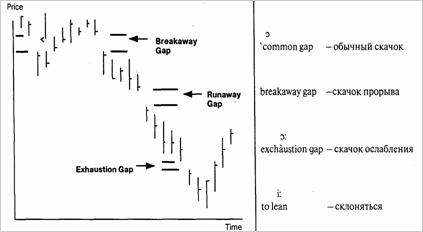Gaps
Consecutive transactions can be dealt at significantly different prices. Price gaps that occur within a day's trading do not show up on a bar graph because the graph will show the range for the day. However, if the closing high on one day is below the low of the next day (or one day's low is above the next day's high), a gap actually shows on the bar graph. There are four basic kinds of gap. One, the runaway gap. reflects a continuation of the move. A runaway gan appears after a significant move has already occured. In indicates that the move has received a second wind and is ready to go higher with relative ease. The runaway gap frequently occurs approximately halfway along a major move. Common Gap
e consecutive
л runaway
as 'gap
a second wind
последующий — убегание
— скачок усиление

Two of the other three kinds of gap, the common gap and
the breakaway gap, are important in terms of market reversals.
The common gap materializes on one day but subsequently gets filled in. It often is nothing more than the result of thin markets.
It is viewed by most practitioners as a false signal, although it can be an indication that the market is leaning to break out in the direction of the gap.
The breakaway gap frequently occurs at the end of a con
Solidation phase, at the end of a key price pattern, or after a major support, or resistance line has been broken. It usually represents the beginning of a fairlv major move. A breakaway gap is often sharp because those with wrong positions not only will get out of the bad position they are in, but will also establish positions in line with the market move. A breakaway gap may get partially filled in, but mot totally.
The fourth kind of gap. an exhaustion gap, occurs near the
end of the market move. The market tries to jump forward, but there is little support for the move, and the market quickly retraces. When prices come back through the gap, it is a fairly reliable barometer that the move is over. The exhaustion gap often correlates to the period when small players enter the market.
When that happens, in is another signal to be a contrarian and to expect the market to reverse.
in line with
— в соответствии с
ei
retrace
— возвращаться по пройденному пути
Э:
correlate
— соответствовать
еэ
contrarian
— идущий от противного
to fill
- наполнять
